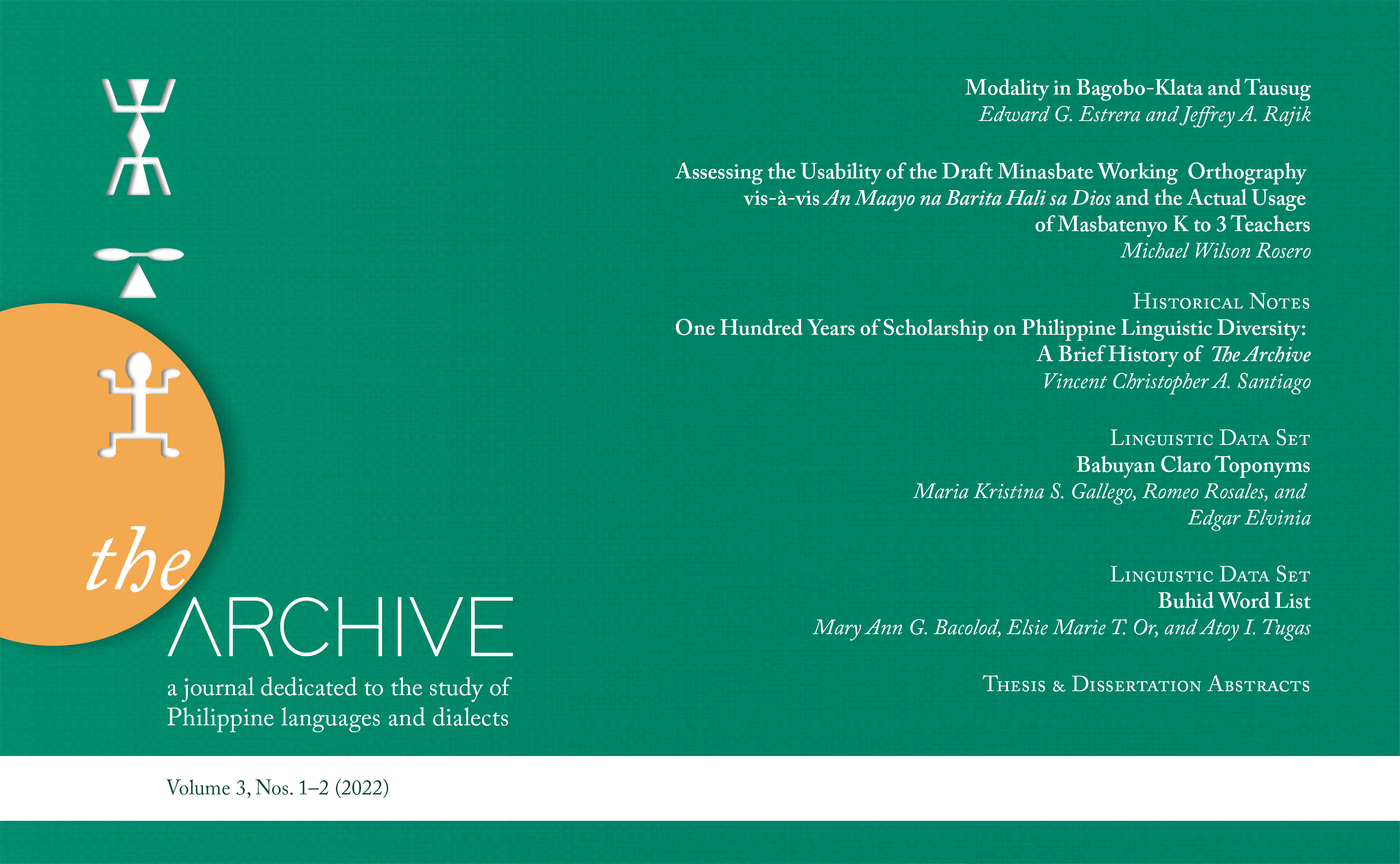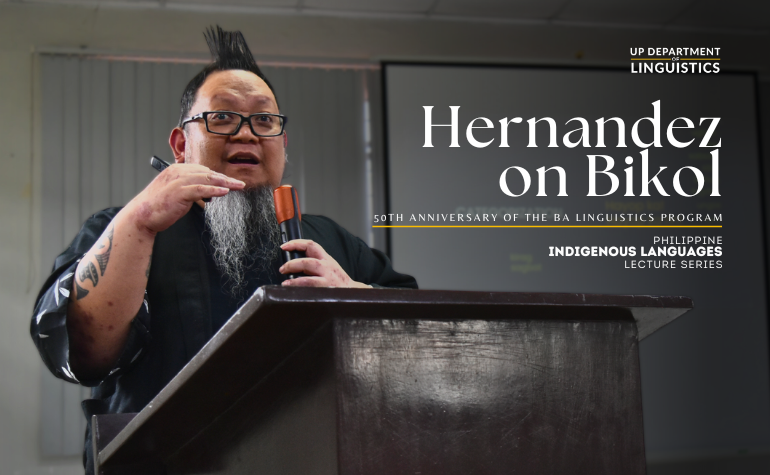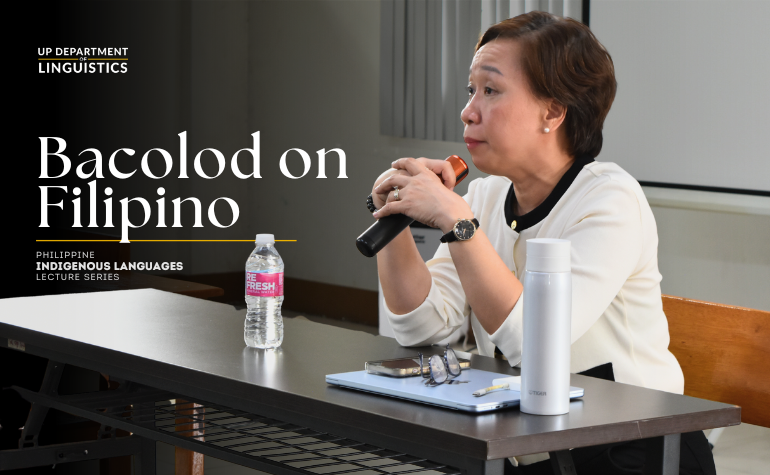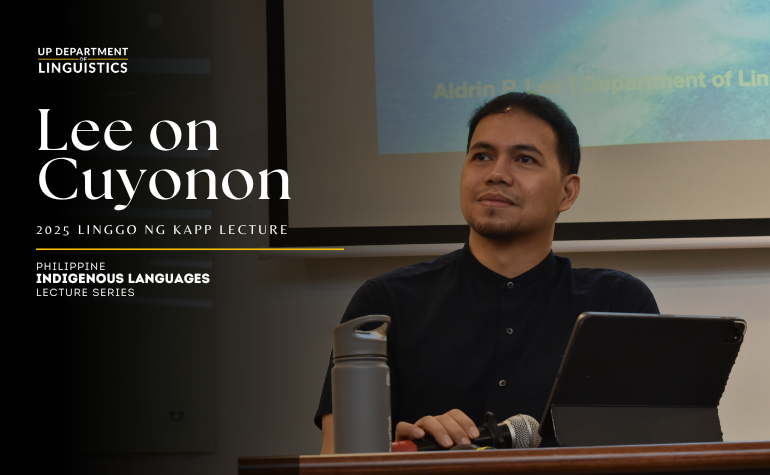
The Archive, the official publication of the UP Department of Linguistics, has released its third regular volume. This latest installment of the journal is a historic landmark, as it coincides with the centennial founding anniversary of the Department. This issue, composed of two research articles, a historical note, two word lists, and a new section featuring thesis and dissertation abstracts, are in keeping with the Department’s mandate as a bastion of linguistic scholarship and as an institution that seeks to serve the language-related needs of the nation.
The first article is “Modality in Bagobo-Klata and Tausug,” co-authored by Edward G. Estrera and Jeffrey A. Rajik. Their work compares modality between the two languages using semantic and morphosyntactic features, as well as tracing the lexical origins of modality expressions. This study offers insights into the typological structure of modality in Bagobo-Klata and Tausug, which will also enrich the scholarship of Philippine languages in general and contribute to the assessment of the applicability of linguistic typological theories.
The second article is “Assessing the Usability of the Draft Minasbate Working Orthography vis-à-vis An Maayo na Barita Hali sa Dios and the Actual Usage of Masbatenyo K to 3 Teachers” by Michael Wilson Rosero. This study compares the draft Minasbate Working Orthography (MWO) with the written literature in the language and also investigates the actual usage of the MWO by its stakeholders. With Mother Tongue-Based Multilingual Education (MTB-MLE) at the forefront of today’s discussions on educational language policy, this paper highlights the importance of taking into account the insights and experiences of sectors who are directly impacted by policies pertaining to language and language use.
The historical note “One Hundred Years of Scholarship on Philippine Linguistic Diversity: A Brief History of The Archive” written by Vincent Christopher Santiago traces the history of the journal as the publication arm of the UP Department of Linguistics and an important platform for the dissemination of research outputs on Philippine languages and dialects since its beginnings in the 1920s. The essay provides a glimpse on the research interests of Filipino and foreign researchers interested in Philippine linguistics. It also chronicles the research climate on Philippine linguistics at each period of the institutional history of the Department, and the general history of linguistics in the country.
The first linguistic data set is “Babuyan Claro Toponyms,” compiled by Maria Kristina S. Gallego, Romeo Rosales, and Edgar Elvinia. Toponyms (place names) were collected from Babuyan Claro, an Ibatan-speaking island in northern Philippines. Documenting such data is an important endeavor in ensuring the intergenerational transmission of the language, as it gives an account of the collective history and local knowledge within the community. More than just collecting data, the authors put forward the essential role of this research endeavor as a way to map the geographic space of the community’s sociolinguistic landscape.
The second linguistic data set is the “Buhid Word List,” compiled by Mary Ann G. Bacolod, Elsie Marie T. Or, and Atoy I. Tugas. The data is a product of the collaborative project conducted by the two faculty members of the Department (Bacolod and Or) and the members of the ethnolinguistic group Buhid Mangyan. This is an initial output geared towards the creation of a community-initiated dictionary of Buhid, a language in Mindoro, in the hopes of archiving, promoting, and preserving this endangered language.
Beginning with this volume, a new section detailing the abstracts of theses and dissertations produced by the graduate students of the Department is added. Abstracts featured in the current issue are those completed by students under the MA and PhD Linguistics programs from Academic Year (AY) 2017-2018 (during the official re-revival of The Archive) up to AY 2021-2022. According to Editor-in-Chief Jem R. Javier, this section hopes “…to inform researchers, educators, students, as well as other interested individuals, groups, communities, and agencies, regarding the kind, range, and diversity of Philippine linguistic scholarship that our Department, through our graduate students, has generated throughout its institutional history.”
In all of the featured works in this volume, the contributors stress the value of the role of the speakers of the languages under study and the collaboration with communities in research undertakings—that they are not just passive stakeholders impacted by language policies, but that they serve the crucial role of language consultants and even research collaborators in the study of their own language and who may have a say in the direction towards which the linguistic research activity must be headed.
The production of this issue was managed by the team of Assoc. Prof. Jem Javier (editor-in-chief), Asst. Prof. Divine Angeli Endriga (managing editor),Mr. James Dominic Manrique (layout, formatting, and cover design), with administrative assistance of Ms. Victoria Vidal. This latest issue can be accessed via this link.
__________________________________
The Archive was originally published in the 1920s by Otto Johns Scheerer as a repository for working papers of the Department’s graduate students. It now publishes research outputs in three different categories: the Regular Issue, which is the peer-reviewed publication for original works dealing primarily but not exclusively with Philippine languages and dialects; the Special Publication, which is a venue for publishing single, extensive works on Philippine languages, translations, and other similar works; and the Classics series, which reprints monumental works in Philippine linguistics that paved the way for further research in the field and continue to influence current studies on Philippine languages.
The Archive accepts submissions all year round. It is officially hosted by the UP Diliman Office of the Vice-Chancellor for Research and Development, through the UP Diliman Journals Online website, where previous and current issues of the journal may be freely accessed and downloaded. More information about the journal and submission guidelines are available through this link.
Published by



